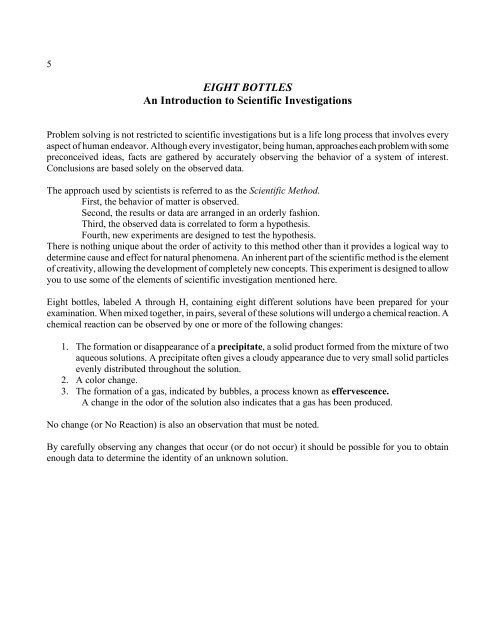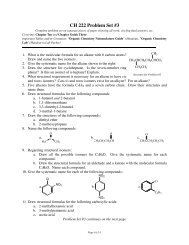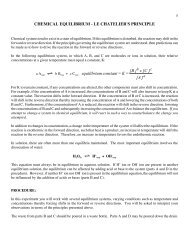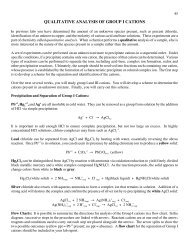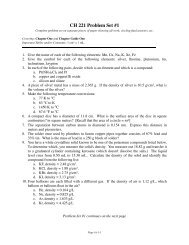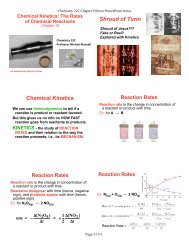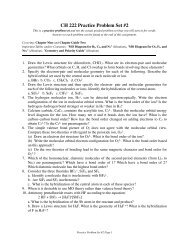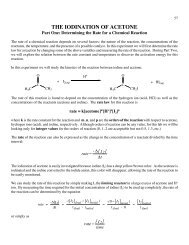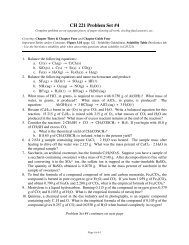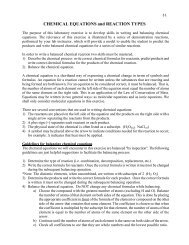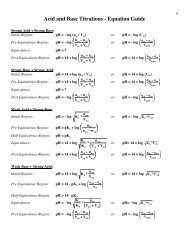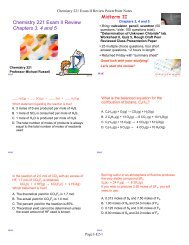Eight Bottles - The Chemistry 104 Homepage
Eight Bottles - The Chemistry 104 Homepage
Eight Bottles - The Chemistry 104 Homepage
- No tags were found...
You also want an ePaper? Increase the reach of your titles
YUMPU automatically turns print PDFs into web optimized ePapers that Google loves.
5EIGHT BOTTLESAn Introduction to Scientific InvestigationsProblem solving is not restricted to scientific investigations but is a life long process that involves everyaspect of human endeavor. Although every investigator, being human, approaches each problem with somepreconceived ideas, facts are gathered by accurately observing the behavior of a system of interest.Conclusions are based solely on the observed data.<strong>The</strong> approach used by scientists is referred to as the Scientific Method.First, the behavior of matter is observed.Second, the results or data are arranged in an orderly fashion.Third, the observed data is correlated to form a hypothesis.Fourth, new experiments are designed to test the hypothesis.<strong>The</strong>re is nothing unique about the order of activity to this method other than it provides a logical way todetermine cause and effect for natural phenomena. An inherent part of the scientific method is the elementof creativity, allowing the development of completely new concepts. This experiment is designed to allowyou to use some of the elements of scientific investigation mentioned here.<strong>Eight</strong> bottles, labeled A through H, containing eight different solutions have been prepared for yourexamination. When mixed together, in pairs, several of these solutions will undergo a chemical reaction. Achemical reaction can be observed by one or more of the following changes:1. <strong>The</strong> formation or disappearance of a precipitate, a solid product formed from the mixture of twoaqueous solutions. A precipitate often gives a cloudy appearance due to very small solid particlesevenly distributed throughout the solution.2. A color change.3. <strong>The</strong> formation of a gas, indicated by bubbles, a process known as effervescence.A change in the odor of the solution also indicates that a gas has been produced.No change (or No Reaction) is also an observation that must be noted.By carefully observing any changes that occur (or do not occur) it should be possible for you to obtainenough data to determine the identity of an unknown solution.
6PROCEDUREObtain a tray with dropper bottles containing solutions labeled A-H. In each dimple of a spot plate,combine 3 drops each of various combinations of two solutions. [i.e.: three drops of A and three drops ofB; then three drops of A and three drops of C; etc.] Mix with a clean stirring rod, and record yourobservations (color change or precipitate formation along with the color of the precipitate) in the datatable provided. If you detect no change, simply write NR for no reaction.[Note: To prevent cross contamination, it is important to clean the stir rod between each mixture. You cansimply wipe it with a damp paper towel or swish it around in a beaker of water and wipe off betweenmixtures.]*Be sure to record your results for each reaction combination in the two corresponding boxes on youranswer sheet. [i.e. When you mix solutions A and B, record the results under A vs B and B vs A.] Whenthe spot plate is full, simply rinse it off into the waste bottle with distilled water and continueexperimenting.Unknowns: Before obtaining your two unknown solutions, show your instructor your completed data sheetfor approval. When you choose two unknowns, they must be at least 10 numbers apart. Record their ID #son your data sheet. Experiment with your unknown by mixing three drops with the contents of each of thebottles labeled A-H. [Be sure to use a clean eye dropper for each unknown to avoid cross contamination.]Remember to mix only two solutions at a time. Record your observations on the data sheet. Determinewhat letter bottle (A-H) your unknown is. It is not necessary to determine the chemical makeup of theunknown, only the corresponding bottle letter. If you are unhappy with your results, you may repeat theappropriate steps or choose a different unknown.Clean up: When you are satisfied with your results, please clean your lab area. Anything you took from alab drawer should be placed in the drawer where you found it for future labs. Anything you took from thelab cart should be neatly placed back on the cart. If the lab room and cart are left in a disorderly fashion,ALL students from that lab section will lose points from their lab grade. Please remember that the sink isNOT a garbage can!Before next weeks lab, complete the backside of the lab report. <strong>The</strong> lab report is due at the BEGINNINGof the lab period one week from completion. Late labs (any time after the first two minutes of lab) willhave points deducted. Labs may be turned in up to one week late for partial credit. After one week, labs areworth ZERO. Two ZERO grades on lab reports will lead to a ZERO for your lab grade and arecommended withdrawal from the course.If you are absent the week of a lab, you must call your instructor that day and leave a message explainingwhen you plan to make up the lab. Failure to leave a message will result in your lab being considered lateand points deducted. Most labs require the full two hour lab period so you will need to come to another labsection to makeup your missed lab. You have one week to make up the missed lab. Please consult yourMHCC schedule guide for days and times of chemistry labs. If you make up a lab, be certain to have thatinstructor clearly sign and date your lab data page.
7EIGHT BOTTLESName:_______________Lab Partner:Lab Section:Solutions A B C D E F G HAXBXCXDXEXFXGXHXUnknown#______Unknown#______
8Unknown # ________Unknown # ________Bottle ID (A-H) _________Bottle ID (A-H) _________POST LAB QUESTIONS:1. Briefly explain how you determined what bottle letter your unknown corresponded to.2. Briefly explain why you only mixed two solutions at a time and not three or more.3. How would you detect the evolution of a gas upon mixing the solutions?4. Which of the A-H "solution(s)" could be distilled water? How do you know?5. True or False Safety questions (please read page 1 of lab packet “Laboratory Safety & Etiquette)_______ a) If unsure how to dispose of chemicals, just flush down the drain with a lot of water._______ b) It is okay to drink your double mocha latte in lab, especially after a late night studying._______ c) Always point the open end of a heated test tube toward the top student in the class._______ d) Bare feet and open toed shoes are permitted in lab on really hot days._______ e) Obtain a pair of department safety goggles and wear them only when you feel like it._______ g) Leftover chemicals should be returned to the original bottle to save on costs._______ h) Leave dirty glassware for the next lab (or instructor) to clean._______ i) When diluting an acid, pour the acid slowly into water. Never pour water into acid._______ j) If you finish early and are curious about some possible chemical reactions, it is okay tocarry out unauthorized experiments as long as you wear your goggles.


